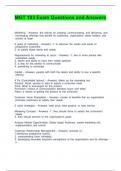Urinary System
OVERVIEW
Excretion: processes that remove wastes and excess materials from body
(metabolic)
Elimination: removal of waste and indigestible food material away from body
ORGAN SYSTEMS INVOLVED IN REMOVING WASTE (NON-URINARY)
Digestive system: provides nutrients and water; excretes food residues
Lungs: provides oxygen and excretes carbon dioxide
Skin: gets rid of heat and is a site for water and salt loss
Liver: destroys substances some excreted as bile in faeces
ORGANS OF THE URINARY SYSTEM
Kidneys:
o excretion of metabolic wastes
o produce urine
o regulate water and salt levels
o regulate nitrogenous wastes & other solutes [urea, ammonia, creatinine
(gives urine yellow colour)]
o control of production of RBCs
o activation of vitamin D
o regulation of acid-base balance
o regulation of blood pressure
Ureters: transports urine to bladder via peristaltic waves of smooth muscle
Urinary bladder: stores urine
Urethra: carries urine from the body
, Urinary System
NEPHRONS
Function is to produce urine
Absorbs 180 litres of fluid from the blood, filter waste and return rest to the blood
Each nephron supplied by afferent arteriole (enters bowman’s capsule and then
divides many times to become network of capillaries that constitutes the
glomerulus)
At the glomerulus, plasma fluid and solutes filtered from blood into capsular
space.
Glomerular capillaries re-join to become efferent arteriole which carries filtered
blood which divides again to form another capillary network that surrounds
tubules in cortex called the peritubular capillaries (remove water, ions and
nutrients which are reabsorbed by tubules)
Some efferent arterioles descend into medulla and divide into capillaries called
vasa recta that supply loop of Henle and collecting duct
Filtered blood eventually flows into larger veins that become single renal vein
leading to inferior vena cava
(gorgeous drawing)
OVERVIEW
Excretion: processes that remove wastes and excess materials from body
(metabolic)
Elimination: removal of waste and indigestible food material away from body
ORGAN SYSTEMS INVOLVED IN REMOVING WASTE (NON-URINARY)
Digestive system: provides nutrients and water; excretes food residues
Lungs: provides oxygen and excretes carbon dioxide
Skin: gets rid of heat and is a site for water and salt loss
Liver: destroys substances some excreted as bile in faeces
ORGANS OF THE URINARY SYSTEM
Kidneys:
o excretion of metabolic wastes
o produce urine
o regulate water and salt levels
o regulate nitrogenous wastes & other solutes [urea, ammonia, creatinine
(gives urine yellow colour)]
o control of production of RBCs
o activation of vitamin D
o regulation of acid-base balance
o regulation of blood pressure
Ureters: transports urine to bladder via peristaltic waves of smooth muscle
Urinary bladder: stores urine
Urethra: carries urine from the body
, Urinary System
NEPHRONS
Function is to produce urine
Absorbs 180 litres of fluid from the blood, filter waste and return rest to the blood
Each nephron supplied by afferent arteriole (enters bowman’s capsule and then
divides many times to become network of capillaries that constitutes the
glomerulus)
At the glomerulus, plasma fluid and solutes filtered from blood into capsular
space.
Glomerular capillaries re-join to become efferent arteriole which carries filtered
blood which divides again to form another capillary network that surrounds
tubules in cortex called the peritubular capillaries (remove water, ions and
nutrients which are reabsorbed by tubules)
Some efferent arterioles descend into medulla and divide into capillaries called
vasa recta that supply loop of Henle and collecting duct
Filtered blood eventually flows into larger veins that become single renal vein
leading to inferior vena cava
(gorgeous drawing)










